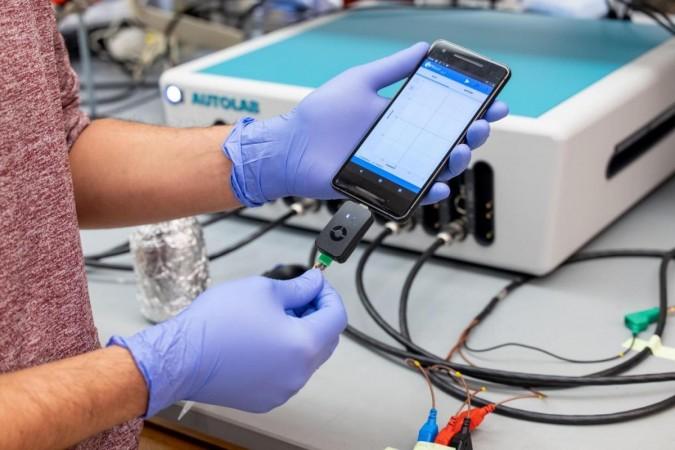At a time when countries such as India are reeling under the pressure of the second wave of the COVID-19 pandemic, the testing capacities of these nations have been overburdened, while vaccines failed to reach even 10 per cent of the total population.
Providing hope of a quicker and cost-effective testing method, scientists have now developed a rapid, low-cost, diagnostic test for SARS-CoV-2 coronavirus infection that provides results within four minutes.
In a new study, researchers from Penn Medicine (the clinical and research unit of the University of Pennsylvania) described the inexpensive and fast diagnostic test known as called RAPID 1.0 (Real-time Accurate Portable Impedimetric Detection prototype 1.0). The test is said to provide results with 90 percent accuracy.
"We feel strongly about the health inequities witnessed during the pandemic, with testing access and the vaccine rollout, for example. We believe inexpensive diagnostic tests like RAPID could help bridge some of those gaps," said Dr. César de la Fuente, leader of the team, in a statement.
Potential Alternative

With the number of infections rising sharply in several regions, timely testing is perhaps the only way of mitigating the pandemic other than safety measures. RT-PCR (reverse transcription-polymerase chain reaction) test is the extensively used diagnostic tool for detecting the SARS-CoV-2 coronavirus.
Despite being widely regarded as the gold standard for testing, it presents practical hurdles when time is of the essence. Some of its limitations are its cost, need for large laboratory space, training of professionals, and most importantly, long waiting time (hours or even days) for results. This is where RAPID can step in. An electrode, which is printed using a screen printer, can detect the SARS-CoV-2 in saliva samples or nasal swabs. Results from the samples can be read through a smartphone or a benchtop instrument.
RAPID utilizes electrochemical impedance spectroscopy (EIS) technology to detect the virus. It is known that coronavirus uses its spike protein (a hook-like protein structure on its surface to latch on to the ACE2 receptor (an enzyme found on the surface of cells) to invade human cells. EIS helps transform the act of binding between the SARS-CoV-2's spike and the ACE2 receptor into an electrical signal the can be easily spotted by technicians. Thus, the signal enables distinguishing between healthy and infected samples.
Quick and Accurate Results

The efficiency of the RAPID was evaluated using COVID-19 samples (both negative and positive) acquired from the Hospital of the University of Pennsylvania. Some of these samples included the highly transmissible UK B117 variant. For the blinded tests, the team examined 139 nasal swab samples whose results had been determined using standard RT-PCR test—109 COVID-19 positive and 30 COVID-19 negative. 50 saliva samples were also analyzed by the team. It was found that RAPID was 90 percent accurate for saliva samples and 87.1 percent accurate for nasal swab samples.
Providing results under four minutes, RAPID is quicker than most methods that are currently employed for the detection of COVID-19. In comparison, serological tests take about 15 to 20 minutes and are around 60 to 70 percent accurate. Additionally, RAPID can also detect the virus even at very low concentrations. This means that an infected individual can be identified even when their viral load is significantly lower or in the initial stages of the infection (around two to three days after the onset of symptoms).
"Quick and reliable tests like RAPID allow for high-frequency testing, which can help identify asymptomatic individuals who, once they learn they are infected, will stay home and decrease spread. We envision this type of test being able to be used at high-populated locations such as schools, airports, stadiums, companies--or even in one's own home," expressed Dr. Marcelo Der Torossian Torres, first author of the study.
Inexpensive and Scalable

What makes this technology unique is its affordability and scalability. Every test can be carried out at room temperature at a cost of $4.67. The electrode is economically viable as thousands of electrodes can be mass-produced on a daily basis using commercially available screen-printers to print the circuit board called eChip. A single laboratory-sized unit is capable of producing 35,000 electrodes daily.
The researchers also built an electrode from filter paper for use in RAPID; increasing its accessibility due to the low cost of the material. Naming it ePAD, the team also showed its applicability in a portable method of rapid. This can be linked to a smart device; thus improving scale and facilitating on-demand testing at the point of care.
As of now, the team's research primarily centered around the development of technologies that can enable understanding, prevention, and treatment of the viral infection. However, the technology utilized in the test can be leveraged for the detection and diagnosis of other viruses that cause sexually transmitted diseases (STDs) or the flu.





!['Had denied Housefull franchise as they wanted me to wear a bikini': Tia Bajpai on turning down bold scripts [Exclusive]](https://data1.ibtimes.co.in/en/full/806605/had-denied-housefull-franchise-they-wanted-me-wear-bikini-tia-bajpai-turning-down-bold.png?w=220&h=138)



